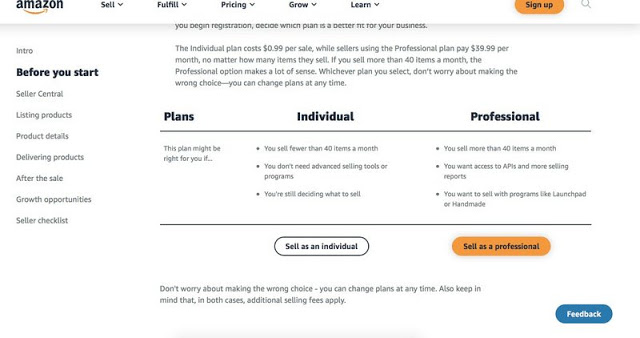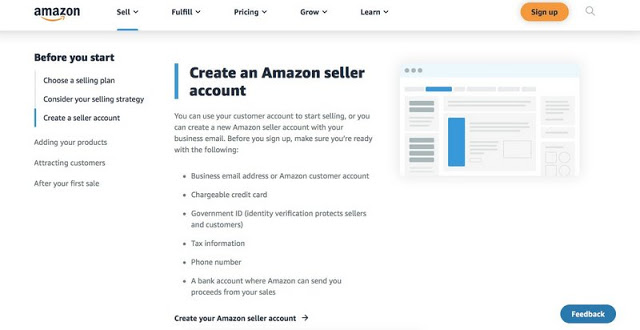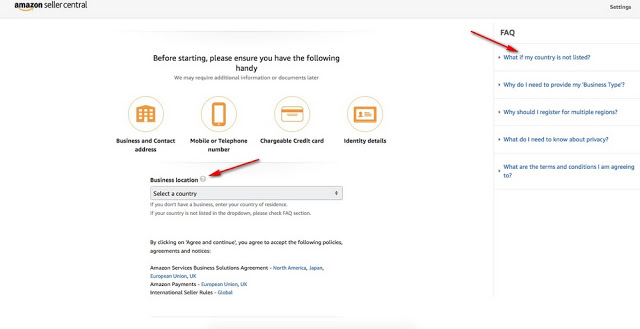For many e-commerce newcomers, the dream of launching their own business on Amazon may seem daunting, requiring time, effort, and knowledge from the very first steps, including creating an Amazon seller account, selecting a niche, developing a business plan, and optimizing work processes. To help you confidently take these initial steps and bring your Amazon business to life, our team has prepared a detailed guide on how to create Amazon seller account in 2023.
Step 1: Choose the right selling plan
Before diving into the world of Amazon selling, it’s essential to select the most suitable selling plan for your business needs. The Individual plan is ideal for sellers who are just starting and have a limited number of products to sell. With this plan, you pay a small fee of $0.99 for each item sold, making it a cost-effective choice for those with lower sales volumes. It also suits sellers who are still testing the waters and want to gauge their products’ market demand without committing to a monthly fee.

On the other hand, the Professional plan caters to sellers with higher sales volumes and ambitious growth plans. For a fixed monthly fee of $39.99, you can list an unlimited number of products. This plan comes with added benefits, such as access to advanced selling tools, advertising options, and eligibility for selling in restricted categories. If you are serious about scaling your business and want access to more features, the Professional plan is the way to go.
Step 2: Gather necessary documents
Creating an Amazon seller account requires a few essential documents to verify your identity and ensure a smooth selling experience. Firstly, you’ll need a business email address to associate with your seller account. Alternatively, you can use an existing Amazon customer account if you already have one. A chargeable credit card is necessary for billing purposes, as Amazon will charge selling fees and other relevant costs to this card.

For identity verification, you must provide a valid government ID, such as a driver’s license or passport. This verification process protects both sellers and customers from potential fraudulent activities. You will also need to submit your tax information to comply with tax regulations and reporting requirements.
Additionally, Amazon requires a phone number to keep you informed about your account and sales activities. Lastly, you’ll need to link a bank account where Amazon can transfer your sales proceeds regularly.

Step 3: Create your Amazon seller account
With all the necessary documents ready, you can begin the process of creating your Amazon seller account. Head to the Amazon website and click on the “Sign up” button. Depending on your preference for the Individual or Professional selling plan, choose the appropriate option.
Next, you’ll be prompted to enter your email address and create a secure password for your account. Ensure that the email address you provide is correct, as all important notifications will be sent to this address.
Step 4: Determine your selling strategy
Deciding on your selling strategy is a critical aspect of building a successful Amazon business. Two primary strategies are available: reselling popular existing products and creating your own brand with unique offerings.
For resellers, the goal is to find products that already have a proven demand on Amazon. You source these products from suppliers or wholesalers and sell them in Amazon’s stores. This approach requires thorough market research to identify trending products and effective pricing strategies to compete with other sellers in the marketplace.
Alternatively, brand owners can manufacture their own products or source goods to sell under a private label. Creating a private label allows you to offer unique products with your brand identity, potentially reducing direct competition. This strategy demands a greater investment in product development, branding, and marketing but can result in higher profit margins and long-term growth opportunities.
Step 5: Find your niche
Discovering the right niche for your Amazon business is crucial for sustained success. Your niche should align with your interests, expertise, and market demand. Conduct thorough research to identify potential niches and assess their viability in terms of competition and profitability.
Start by identifying your personal interests and areas of expertise. Passion for your niche will drive you to deliver high-quality products and better understand your target audience. Next, examine the market to find pain points and unmet needs that your products can address. Studying competitors will provide insights into their strategies, pricing, and product offerings, helping you identify opportunities for differentiation.
Remember that some Amazon categories are open to all sellers, while others require approval for professional sellers. Moreover, some products may be subject to copyright restrictions, limiting their availability to authorized sellers or brand owners. Ensure that you comply with Amazon’s policies and guidelines when choosing your niche.
Step 6: Create a product listing
To list your products on Amazon, you need to create detailed and compelling product listings. These listings serve as your product’s online storefront, and they significantly impact your visibility, conversion rates, and customer experience.
When creating a product listing, include accurate and comprehensive information about your product. Key components of a product listing include:
- Product Identifier: Use a Global Trade Item Number (GTIN), Universal Product Code (UPC), International Standard Book Number (ISBN), or European Article Number (EAN) to uniquely identify your product.
- SKU: Generate a unique Stock Keeping Unit (SKU) to help you manage your inventory efficiently.
- Offer Details: Specify the price, product condition (new, used, refurbished), available quantity, and shipping options.
- Product Details: Provide the product’s name, brand, category, detailed description, and high-quality images. Engaging product images are essential to capture the attention of potential buyers.
- Keywords and Search Terms: Include relevant keywords and search terms in your product listing to improve its visibility in Amazon’s search results. Conduct keyword research to identify phrases that potential customers are likely to use when searching for products similar to yours.
Optimizing your product listing with relevant keywords, accurate information, and enticing visuals will improve your chances of appearing in relevant search results and attracting potential buyers.
Step 7: Consider Fulfillment by Amazon (FBA)
Fulfillment by Amazon (FBA) is a program that allows sellers to store their inventory in Amazon’s fulfillment centers. With FBA, Amazon handles the storage, packing, and shipping of products on your behalf. This service offers several benefits:
- Faster Shipping: FBA enables Amazon Prime customers to enjoy fast and free shipping on eligible products, which can attract more buyers to your listings.
- Enhanced Customer Service: Amazon takes care of customer inquiries, returns, and refunds, which can save you time and provide a better shopping experience for your customers.
- Improved Visibility: Products fulfilled by Amazon often receive a “Prime” badge, indicating their eligibility for fast shipping. This badge can boost the visibility and credibility of your listings.
- Expanded Market Reach: Using FBA can also make your products eligible for international shipping, opening up opportunities to reach customers in other countries.
Step 8: Focus on feedback and reviews
Feedback and reviews play a vital role in building trust with potential customers and influencing their purchase decisions. Positive reviews and high ratings improve your product’s credibility and encourage more people to buy from you.
To earn positive feedback and reviews, focus on providing excellent customer service, delivering quality products, and promptly resolving any issues or concerns. Encourage customers to leave feedback by sending polite follow-up emails after their purchases. However, remember to abide by Amazon’s policies and guidelines regarding communication with buyers.
Negative feedback can happen, but the way you handle it matters. Address any negative feedback constructively and offer solutions to resolve the customer’s concerns. Demonstrating excellent customer service can turn a negative experience into a positive one and may even lead to the customer revising their review.
Why choose Amazon?
Amazon’s immense reach, high website traffic, and robust fulfillment services make it an attractive platform for aspiring e-commerce entrepreneurs. The vast customer base on Amazon offers significant potential for sales and exposure, allowing sellers to tap into a global market.
Additionally, Amazon’s commitment to customer service and user-friendly interface provide a seamless shopping experience, encouraging repeat business and customer loyalty.
Choosing to sell on Amazon can open up opportunities to access new customers, test product ideas, and build a strong brand presence. By leveraging Amazon’s platform and services, you can focus on growing your business and reaching your entrepreneurial goals.


